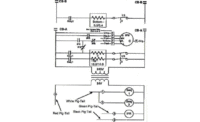
Figure A. (Click on the diagram for an enlarged view.)
SOLUTION TO OUR LAST PROBLEM
We begin this edition with the answer to our “An Older Gas Furnace That’s Blowing Cool Air” problem presented in the Oct. 8, 2007 issue.The failed component was the transformer. A reading of 120 VAC at the PR-1 and PR-2 connections and a 0-VAC reading (which should have been 24 VAC) at SEC-1 and SEC-2 proved the component failure.

Figure B. (Click on the diagram for an enlarged view.)
From those readers who sent in the correct diagnosis, the prize drawing winner is Ed Herget.
And, now on to this issue’s problem.

Figure 1. (Click on the diagram for an enlarged view.)
AN ELECTRIC HEATING SYSTEM THAT'S NOT HEATING ENOUGH
In this troubleshooting scenario we’re dealing with a resistance heating system, and the customer has called to say that the unit is no longer keeping them warm “like it used to.” This particular unit, which can be used in conjunction with a heat pump, or only as an electric furnace, is not paired with a refrigeration system. It has been in service for several years with no previous service calls.When you arrive, you note that the temperature in the building is mildly chilly, and that the air handler motor is operating on low speed. The thermostat is set to call for heat, but the temperature rise is insufficient. Removing the access panel of the unit, you locate the schematic diagram (shown in Figure 1) and begin your troubleshooting process with a voltmeter.
Noting that the three heating elements (HE1, HE2, and HE3) are controlled by two relays (HR1 and HR2), and that a limit control (LC1, LC2, and LC3) is wired in series with each element, you get the following readings:
1.240 VAC at the terminal connections for HE1.
2.240 VAC at the terminal connections for HE2.
3.240 VAC at the terminal connections for HE3.
When testing the circuits with a clamp-on ammeter, you note:
1.0 Amps on the wiring connection to HE2.
2.0 Amps on the wiring connection to HE1.
3.The manufacturer’s listed current draw on the wiring to HE3.
And your troubleshooting question is: What needs to be done in order to get this unit operating normally again?
If you have the answer to this question, click onwww.technicaltrainingassoc.comand submit your diagnosis via The NEWS link. All correct answers received by the deadline of Dec. 28, 2007 will be entered into a prize drawing for a Fieldpiece SC46 Clamp-on Digital Meter. The correct answer to this question, along with the results of the drawing, will be published in the Feb. 4, 2008 issue.
Publication date:12/03/2007









